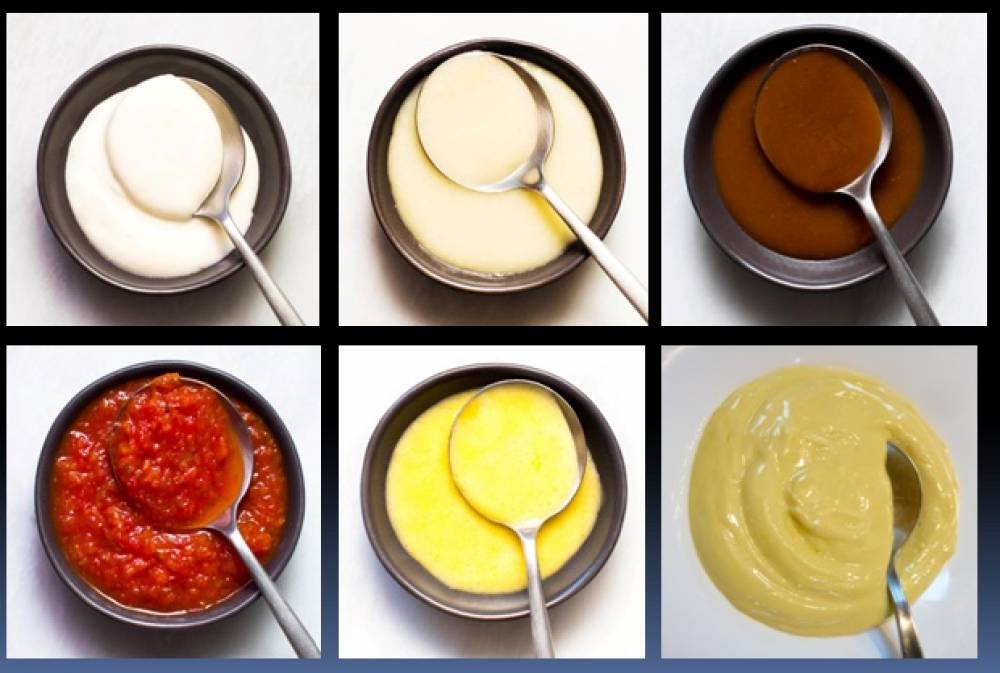The Five Mother Sauces of Western Cuisine
The concept of "mother sauces" (sauces mères) was formalized in French cuisine to standardize culinary techniques and provide versatile bases for derivative sauces. Originating in the 19th century, these sauces were refined by chefs like Marie-Antoine Carême and Auguste Escoffier, building on earlier culinary traditions. Each sauce has a distinct base, preparation method, and role in Western cuisine, particularly in French cooking.
1. Béchamel Sauce
Definition
Béchamel is a creamy, white sauce made from a roux (equal parts butter and flour) cooked with milk, often seasoned with salt, pepper, and sometimes nutmeg. It is a versatile base for dishes like gratins, lasagnas, and cream sauces.
Origin
- Historical Roots: Béchamel’s origins are debated, but it likely evolved from older French sauces like sauce blanche, a simple flour-thickened milk sauce. It is named after Louis de Béchamel, a 17th-century financier and steward to Louis XIV, though there’s no definitive evidence he created it. Some suggest the sauce was formalized by François Pierre de la Varenne, author of Le Cuisinier François (1651), who introduced roux-based sauces.
- Development: By the 19th century, Carême included Béchamel in his classification of mother sauces, emphasizing its role as a foundational sauce. Escoffier later refined it, standardizing the use of a light roux and milk.
Key Characteristics
- Ingredients: Butter, flour, milk, salt, pepper, optional nutmeg.
- Texture: Smooth, creamy, and velvety.
- Preparation: A white roux (butter and flour cooked briefly without browning) is whisked with heated milk, simmered until thickened, and strained for smoothness.
- Derivatives: Mornay (with cheese), Crème (with cream), Soubise (with onions).
Facts and History
- Béchamel was one of the earliest mother sauces, reflecting the French shift toward refined, roux-based sauces in the 17th century.
- It was originally thickened with bread crumbs or almond paste in medieval cooking before roux became standard.
- In Italian cuisine, Béchamel (called besciamella) is essential for dishes like lasagna, suggesting a possible Italian influence on its development.
- Escoffier’s 1903 Le Guide Culinaire cemented its modern form, emphasizing a light, delicate texture.
2. Velouté Sauce
Definition
Velouté is a light, velvety sauce made from a blonde roux (butter and flour cooked until lightly golden) combined with a clear stock (chicken, veal, or fish). It is a base for numerous lighter sauces.
Origin
- Historical Roots: Velouté emerged in the 17th and 18th centuries as French cuisine moved away from heavily spiced medieval sauces. Its name, derived from the French word for “velvety,” reflects its smooth texture.
- Development: Carême classified Velouté as a mother sauce, distinguishing it by its use of clear stock rather than milk or brown stock. Escoffier refined it further, specifying stocks for different proteins (e.g., chicken for poultry dishes, fish for seafood).
Key Characteristics
- Ingredients: Butter, flour, clear stock (chicken, veal, or fish), salt, pepper.
- Texture: Smooth, light, and glossy.
- Preparation: A blonde roux is cooked with stock, simmered to thicken, and strained to remove impurities.
- Derivatives: Suprême (with cream and chicken stock), Allemande (with egg yolk and lemon), Normande (with fish stock and cream).
Facts and History
- Velouté’s versatility comes from the choice of stock, allowing it to pair with various proteins.
- It was historically used to elevate simple dishes, such as poached chicken or fish, in aristocratic French households.
- The sauce requires high-quality stock, as its flavor is prominent, unlike Béchamel’s neutral milk base.
- Escoffier’s standardization made Velouté a cornerstone of haute cuisine, particularly for delicate dishes.
3. Espagnole Sauce
Definition
Espagnole, or “Spanish sauce,” is a rich, brown sauce made from a dark roux, brown stock (typically veal or beef), mirepoix (onions, carrots, celery), tomatoes, and herbs. It forms the base for robust, meaty sauces.
Origin
- Historical Roots: Named “Espagnole” due to the use of tomatoes, which were associated with Spanish cuisine after their introduction to Europe from the Americas in the 16th century. It likely evolved from earlier brown sauces thickened with bread or almonds.
- Development: Carême included Espagnole in his mother sauce system, emphasizing its complex flavor from roasted bones and vegetables. Escoffier refined it, reducing the heavy reliance on meat reductions and incorporating tomato purée for balance.
Key Characteristics
- Ingredients: Butter, flour, brown stock, mirepoix, tomato purée, bay leaf, thyme.
- Texture: Thick, rich, and glossy.
- Preparation: A dark roux is cooked with brown stock, mirepoix, and tomatoes, simmered for hours to develop depth, then strained.
- Derivatives: Demi-glace (reduced with wine), Bordelaise (with red wine and shallots), Chasseur (with mushrooms and white wine).
Facts and History
- Espagnole’s name reflects 17th-century European culinary politics, as Spain was seen as a source of new ingredients like tomatoes.
- It was historically labor-intensive, requiring roasted bones and long simmering to achieve its depth.
- The sauce fell out of favor in modern cuisine due to its richness but remains a classic in French culinary training.
- Escoffier’s demi-glace, a reduction of Espagnole and brown stock, became one of the most iconic derivative sauces.
4. Tomato Sauce
Definition
Tomato sauce (sauce tomate) is a robust, tangy sauce made from tomatoes, aromatics (onions, garlic), herbs (basil, thyme), and sometimes stock or a roux for thickening. It is a staple in both French and Italian cuisines.
Origin
- Historical Roots: Tomatoes arrived in Europe from the Americas in the 16th century but were initially considered ornamental or toxic. By the 18th century, they were used in French and Italian cooking. The French tomato sauce likely drew from Italian traditions, particularly Neapolitan tomato-based ragùs.
- Development: Carême included a heavily cooked, meaty tomato sauce in his mother sauce system, often thickened with a roux. Escoffier simplified it, focusing on fresh tomatoes and lighter seasoning, aligning with modern tastes.
Key Characteristics
- Ingredients: Tomatoes (fresh or canned), onions, garlic, herbs, optional stock or roux.
- Texture: Thick, smooth, or slightly chunky, depending on preparation.
- Preparation: Tomatoes are cooked with aromatics and herbs, sometimes thickened with a roux or reduced naturally, then strained or left rustic.
- Derivatives: Marinara (simpler, with garlic and basil), Provençale (with olives and herbs), Creole (with peppers and spices).
Facts and History
- Carême’s version was more complex, often including veal stock and roux, while Escoffier’s was closer to modern tomato sauces.
- In Italian cuisine, similar sauces (e.g., pomodoro) predate the French version, suggesting cross-cultural influence.
- The sauce’s prominence grew with the rise of canned tomatoes in the 19th century, making it more accessible.
- Tomato sauce is unique among mother sauces for its vegetable base, contrasting with the stock or dairy bases of others.
5. Hollandaise Sauce
Definition
Hollandaise is a warm, emulsified sauce made from egg yolks, butter, lemon juice, and seasonings. It is delicate and rich, often served with eggs, vegetables, or fish.
Origin
- Historical Roots: Named “Hollandaise” (Dutch sauce), it likely originated in France, possibly inspired by Dutch butter-based sauces. Its earliest forms date to the 17th century, with recipes appearing in French cookbooks like Le Cuisinier François.
- Development: Carême classified it as a mother sauce, though it was less versatile than others due to its delicate nature. Escoffier refined its preparation, emphasizing a stable emulsion and precise technique.
Key Characteristics
- Ingredients: Egg yolks, clarified butter, lemon juice, salt, optional cayenne.
- Texture: Smooth, creamy, and glossy.
- Preparation: Egg yolks are whisked with lemon juice over gentle heat, then emulsified with melted butter to create a stable, velvety sauce.
- Derivatives: Béarnaise (with tarragon and vinegar), Maltaise (with orange juice), Mousseline (with whipped cream).
Facts and History
- Hollandaise’s name may reflect Dutch butter exports to France in the 17th century or a nod to Dutch culinary influence.
- It is the most technically challenging mother sauce due to the risk of curdling or breaking the emulsion.
- The sauce gained fame through dishes like Eggs Benedict, though its origins are older.
- Modern variations often use blenders for easier emulsification, but classical training emphasizes whisking by hand.
Broader Historical Context
- Carême’s Influence: In the early 19th century, Marie-Antoine Carême, known as the “king of chefs,” formalized the mother sauce system, identifying four foundational sauces: Béchamel, Velouté, Espagnole, and Allemande (later replaced by Hollandaise in Escoffier’s system). His work emphasized structure and refinement in French cuisine.
- Escoffier’s Refinement: In Le Guide Culinaire (1903), Auguste Escoffier streamlined Carême’s system, replacing Allemande with Hollandaise and adding Tomato as a distinct mother sauce. His codification made the sauces accessible to professional kitchens worldwide.
- Cultural Impact: The mother sauces spread through French culinary schools and restaurants, influencing Western cuisine in Europe, North America, and beyond. They remain a cornerstone of classical culinary training, though modern cuisine often favors lighter, simpler sauces.
- Evolution: Nouvelle cuisine in the late 20th century reduced reliance on heavy, roux-based sauces like Espagnole, but Béchamel, Hollandaise, and Tomato remain widely used in contemporary cooking.
Interesting Facts
- The mother sauces reflect the evolution of French cuisine from medieval spice-heavy dishes to refined, technique-driven preparations.
- Roux, a mixture of flour and fat, is central to three of the five sauces (Béchamel, Velouté, Espagnole), highlighting its importance in French cooking.
- Hollandaise is unique as an emulsified sauce, requiring no thickening agent like flour or starch.
- The sauces’ versatility allows chefs to create hundreds of derivative sauces, making them a foundation of culinary creativity.
- The tomato’s journey from a New World curiosity to a mother sauce ingredient underscores the global exchange of ingredients in culinary history.
· Béchamel – Roux + milk. Base for creamy sauces.
· Velouté – Roux + light stock. Used in soups.
· Espagnole – Roux + brown stock. Rich, deep flavor.
· Tomato – Tomato-based, thickened. Pasta staple.
· Hollandaise – Emulsified eggs + butter. Breakfast classic.






















